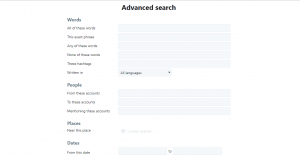How Twitter Advanced Search can Benefit a Business
Let’s talk Twitter. It’s something that has skyrocketed since its release. If we think about all the different social media platforms that came before – MySpace, MSN, even Facebook to an extent – they all became popular very quickly and their fire burnt fast, and what is left of them is a dull ember of a memory.Twitter, however, has stayed at the top of its game with over 336 million users worldwide. But due to its popularity, it is incredibly hard to stay on top of. It is constantly changing, and trends come and go. For a business, this can be a nightmare.
The thought of posting something that isn’t quite up to date and current is a fear in a lot of people when they start their marketing on social media, but that shouldn’t stop you.
Twitter can be a goldmine for a business. The possibility you have to be put in front of as many potential customers in unlimited. But, with over 8,000 tweets published every second, it’s easy to lose track of particular posts and interactions.
So how do you stay on top? Easy. All you need to know is how to optimise the Twitter Advanced Search function.
You might feel a little confused, why should you as a brand know how to search for yourself if you need your customers to be doing it? Well, if YOU know how to use it, and you know how you want to be found, then you can start to customise your twitter output to match that.
It’s a tactic that can be applied in a lot of different situations; knowing what your end goal is and working backwards. How can you know how to get somewhere if you don’t know where you’re trying to go?
The beauty of this function is that anyone can access the Twitter Advanced Search, they don’t need to be a business, but it can really benefit one.
For instance, if I were to just search #pizza, the first post that comes up is something about dominos. But if I used the advanced search and still used the #pizza, but also included the phrase “How to” a completely different list comes up.
You might not be searching for pizza when it comes to your business (or maybe you are and that would make me very jealous) but that’s just an example of how it works. You can also separate out hashtags from phrases; exclude certain words; include specific accounts that the tweet came from, went to, or was mentioned in, right the way down to setting specific dates that the tweet was published between. Just remember to separate them out with quotation marks for each word when you search them.

So, if you know how you want your business to be found through the Advanced Search tool you can start to make changes to your tweets and social posts to get the best results.
Obviously, this tool is not going to do your job for you, you still have to decide on the hashtags you want to use and the people/companies you want to tag in your posts for the best engagement. If you know what specific phrases people use when they talk about you then start to use those phrases in your posts.
Along with using this tool to help customers find you, you can use it to find how your customers are talking about you. Twitter is a great place for people to post complaints. Once something is out on the Internet, it is there forever, and no business wants a complaint to be associated with their company forever. Once a complaint or criticism has been made most companies will do whatever they can to rectify the situation and keep a good image for themselves on social media.
Using the advanced search tool you can find the complaints and negative comments that are made that go under your radar. What’s more is you might look even better to someone if you found the comment even if they didn’t tag you or they spelled your name incorrectly.
You don’t necessarily have to search with words either; you can search for emoticons in reference to your brand. It can be a quick way to see exactly how your customers are feeling with your business and service.
Another great way to use this tool is to stalk your competitors… With the Advanced Search, you can view your competitor’s social feed, see what their customers engage with and like about their social media and then apply that to your own customers. Don’t copy them outright, but edit and change what you like about their feed for your own audience.
Through this tool you won’t become lost in the never-ending Twitterverse, you can review and monitor how you are doing as a business and know exactly what is the most engaging content for your demographic and how to improve. Happy Tweeting!




